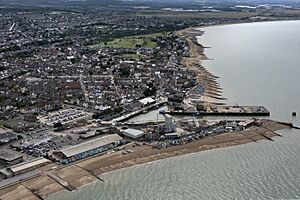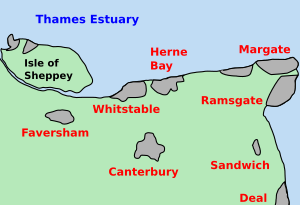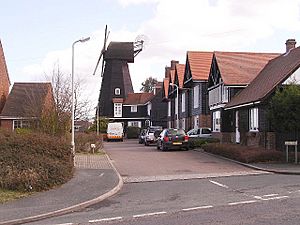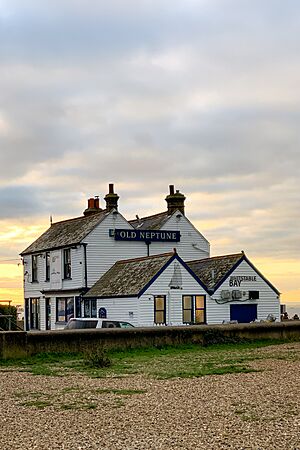Whitstable facts for kids
Quick facts for kids Whitstable |
|
|---|---|
 |
|
| Population | 32,100 (2011 Census) |
| OS grid reference | TR107667 |
| District | |
| Shire county | |
| Region | |
| Country | England |
| Sovereign state | United Kingdom |
| Post town | Whitstable |
| Postcode district | CT5 |
| Dialling code | 01227 |
| Police | Kent |
| Fire | Kent |
| Ambulance | South East Coast |
| EU Parliament | South East England |
| UK Parliament |
|
Whitstable is a town on the north coast of Kent, England. It is located where the Swale river meets the Greater Thames Estuary. Whitstable is about 5 miles (8 km) north of Canterbury. It is also 2 miles (3 km) west of Herne Bay.
The town was once known as Whitstable-on-Sea. It became famous for its delicious oysters. People have collected these oysters from the sea since Roman times. Today, the town still celebrates its oyster history. The annual Whitstable Oyster Festival takes place every summer.
In 1830, the Canterbury and Whitstable Railway opened. This was one of the world's first passenger train services. In 1832, a harbour was built. The railway line was extended to help move coal and other goods. The railway is now closed, but the harbour is still very important for the town. The old railway path is now a popular cycle path that leads to Canterbury.
Contents
Whitstable's Past
Archaeologists have found signs that people lived in the Whitstable area a very long time ago. This includes the Palaeolithic (Stone Age), Bronze Age, and Iron Age. Oysters were gathered here even in Roman times. Parts of a Roman building have been found in the town centre. Old records show that Saxon people also lived here. They made salt and traded goods by the coast.
In the 19th century, many Roman pots were found in the sea near Whitstable. These were discovered while people were dredging for oysters. An offshore rock near the town is thought to be an island mentioned by an ancient writer named Ptolemy.
Early Settlements
The town was first written about in the Domesday Book in 1086. It was called Witenestaple. This name means "the meeting place of the white post." This was a local landmark. At that time, Witenestaple was the main place for a large area called a hundred. This area stretched from the coast to the village of Blean, which is 3 km (2 mi) north of Canterbury.
The hundred included three large estates called manors. These were at Seasalter, Northwood, and Swalecliffe. Whitstable hundred was part of a bigger area called the Lathe of St Augustine.
Churches owned the Seasalter and Swalecliffe manors. A noble family managed the Northwood manor for the king. People fished at Seasalter. Salt was made at Northwood. Pigs were raised in the forest at Blean. By 1226, the area's name had changed to Whitstaple. More saltworks opened at Seasalter around 1300. A sea wall was built there in 1325 to stop coastal flooding. The town's history has always been shaped by its changing coastline.
By the late Middle Ages, Whitstable was a key fishing spot in the Thames Estuary. This included oyster fishing. A road connected it to Chestfield, where people ate seafood. It also connected to the Forest of Blean.
Growth and Industry
By 1413, the three manors had joined to form the Whitstaple manor. It was sold to a religious group in Essex. King Henry VIII took the manor during the Dissolution of the Monasteries in the 16th century. He gave it to the Minter family. A special permission was given in 1574 to the manor owner to fish its oyster beds. In the same year, the lands at Tankerton became part of the manor. A factory making copperas (a chemical) started at Tankerton in 1588. It ran until about 1830. By 1610, the name Whitstaple became Whitstable.
Around the mid-1700s, ships started carrying goods and people between London and Whitstable. A toll road was built to Canterbury. These transport improvements helped Whitstable grow as a seaside resort. The first ads for bathing machines (for swimming) appeared in 1768. In 1790, the manor was sold to private owners. Three years later, a new company bought the rights to harvest oysters. This was the Company of Free Fishers and Dredgers of Whitstable.
From about 1775 to 1875, fishing boats from Barking and other ports would collect lugworms and whelks from Whitstable. These were used as bait for catching prime fish near Iceland. In the 1880s, Whitstable was known for its "unrivalled" position in the oyster world.
The Crab and Winkle Railway
On May 3, 1830, the world's first steam-powered passenger and freight railway opened. It was run by the Canterbury and Whitstable Railway Company. The line was six miles (10 km) long. It ran from Canterbury to Whitstable town centre. The railway's initials (C&WR) and Whitstable's shellfish industry led to its nickname: the Crab And Winkle Railway. The line brought coal from ships in Whitstable to Canterbury. At this time, Whitstable also had a busy shipbuilding industry.
Trains were pulled by a locomotive for part of the journey. On hills, they were pulled by ropes using steam-powered engines. The locomotive used was the Invicta. It was built by Robert Stephenson. Whitstable harbour, also designed by Stephenson, opened in 1832. The railway line was extended to the harbour. This allowed goods, mostly coal, to be moved directly from ships to trains. In 1834, the world's first season tickets were sold for this line. Whitstable Harbour was one of the last places on England's east coast where large sailing ships could operate.
The Invicta locomotive was stopped from use in 1840. Horses pulled the trains until a new engine was built. The Invicta was saved and restored. In 1980, it returned to Canterbury for the railway's 150th anniversary. In 2019, Invicta was moved to the Whitstable Museum & Gallery.
Around the time the railway was built, the local Gorrell stream was moved. This created a reservoir called the Backwater. It helped prevent the railway from crossing wet land. The reservoir would fill with stream water and rain. At low tide, the water was released into the new Whitstable Harbour. However, this reservoir sometimes caused flooding in the town. This happened in 1897 and 1953 during very bad weather.
In the early 1970s, an underground tank called the Gorrell Tank was built. The Gorrell Car Park is now above it.
In 1845, the Canterbury and Whitstable Railway Company was bought by the South Eastern Railway. They used steam locomotives that could run the whole line. A direct train route from Whitstable to London opened in 1860. On November 16, 1869, a large fire destroyed 71 buildings in the town. It started near the harbour. Around 1854, the first branch of the Sea Cadet Corps was started in the town.
A factory to make tarmacadam was built next to Whitstable Harbour in 1936. The harbour started to fall apart after World War II. But in 1958, the local council bought and fixed it. They wanted to help the town's economy.
The Crab and Winkle Line closed in 1953. But about a third of the line was reopened in 1999. It is now a footpath and cycleway. A big project called the Horsebridge was finished in 2005. It helped improve an old part of town. New shops, houses, a town square, and a community centre were built. The centre has a performance space and an art gallery.
Oysters
Whitstable is famous for its native oysters. These were produced by three companies: The Faversham Oyster Fishery Company, the Seasalter and Ham Oyster Company, and the Whitstable Oyster Fishery Company. Oysters have been farmed here for centuries. In 1793, the industry became very organized. The companies own the seabed where the oysters grow.
Whitstable oysters have been important for almost 2,000 years. The Romans found them and thought they were a special food. They even shipped them alive back to Rome. Whitstable oysters are now a special product with a Protected Geographical Indication (PGI). At their busiest in the 1850s, these companies sent 80 million oysters a year to market. Back then, oysters were so common they were food for poorer people.
Sadly, the number of native oysters dropped a lot in the first half of the 20th century. Pollution, disease, and too much fishing harmed the industry. By the mid-20th century, it almost disappeared. Now, Pacific Oysters are farmed on the shore at Whitstable. The Whitstable Oyster Fishery Company grows up to 300 tons of shellfish each year. This is a sustainable way to farm them.
How Whitstable is Governed
Since 1918, Whitstable has been part of the Canterbury area for Parliament. The MP for this area is Rosie Duffield from the Labour Party. She was first elected in 2017.
Whitstable is part of the City of Canterbury local government district. This district also includes Herne Bay and Canterbury. The town has five areas called electoral wards: Tankerton, Seasalter, Chestfield, Swalecliffe, and Gorrell. These wards have 9 of the 39 seats on the Canterbury City Council. After the 2023 local elections, Labour held 4 seats, the Green Party 3, and the Liberal Democrats 2. Whitstable does not have its own town council.
Whitstable's Location and Landscape
Whitstable is on the north-east coast of Kent. It lies east of where The Swale river flows into the Greater Thames Estuary. The town is 3 km (2 mi) west of Herne Bay. It is also 8 km (5 mi) north-east of Faversham and 8 km (5 mi) north of Canterbury. Several small villages are nearby. The areas of Tankerton, Swalecliffe, and Chestfield are to the east. Seasalter is to the west, and South Street is to the south. Chestfield has its own local council. There is a protected area of woodland and grassland called Duncan Down to the south-east.
 |
Thames Estuary (sea) | Thames Estuary (sea) | Thames Estuary (sea) |  |
| The Swale (sea) | Herne Bay (town) | |||
| Graveney with Goodnestone (village) | Blean (village) | Chestfield and Swalecliffe (villages) |
The ground in Whitstable is mostly London Clay. Much of the town centre is built on low, wet land. Sea walls are in place to stop flooding from the coast. The land to the east is higher, with slopes down to the sea at Tankerton. The entire north-east Kent coast is a special protected area called a Site of Special Scientific Interest.
A very unusual shingle (pebble) strip of land, called "The Street," goes out into the sea east of the harbour. It was formed by ocean currents. A survey in 2019 found it is made of very heavy London clay. It is what is left of a saltmarsh that once stretched along the Swale river. The Street can only be seen at low tide. People sometimes walk out on it, but they can get trapped by the rising tide. The local RNLI lifeboat crew sometimes has to rescue them.
Weather in Whitstable
The warmest time of year in East Kent is July and August. Temperatures average around 22 °C (71.6 °F). The coolest time is January and February, with temperatures around 2 °C (35.6 °F). Whitstable's temperatures are usually a little higher than the national average. This is partly because the North Downs hills protect it to the south.
East Kent gets about 613 mm (24.1 in) of rain each year. The wettest months are October to January. The national average rainfall is about 870 mm (34 in).
Whitstable's People
| Whitstable Compared | |||
|---|---|---|---|
| 2001 UK Census | Whitstable | Canterbury District | England |
| Total population | 30,195 | 135,278 | 49,138,831 |
| Born outside UK | 4.5% | 5.1% | 9.2% |
| White | 98% | 97% | 91% |
| Asian | 0.6% | 1.6% | 4.6% |
| Black | 0.2% | 0.5% | 2.3% |
| Christian | 74% | 73% | 72% |
| Muslim | 0.3% | 0.6% | 3.1% |
| Hindu | 0.1% | 0.4% | 1.1% |
| No religion | 16% | 17% | 15% |
| Over 65 years old | 23% | 19% | 16% |
| Unemployed | 2.5% | 2.7% | 3.3% |
In the 2001 UK census, the Whitstable area had a population of 30,195 people. There were about 10.3 people per hectare.
Most residents (98.2%) were white. Most (95.5%) were born in the United Kingdom. Christianity was the main religion (74.8%). About 15.8% said they had no religion.
Whitstable has a higher percentage of people over 65 (23%) compared to the national average (16%). This is because it is a popular place for retirement.
Of the 13,155 homes, 49% were married couples. About 30.7% of homes had one person living alone.
Whitstable's Economy
In 2001, most people aged 16–74 in Whitstable were employed. About 35.6% worked full-time, and 13.4% worked part-time. About 10.4% were self-employed. The unemployment rate was 2.5%, which was lower than the national average.
The main activities at the harbour are fishing, processing fish, and handling cargo. The harbour area also has other businesses, like a tarmac factory. It is also a maintenance port for an offshore windfarm. Business parks on the edge of town have large shops, offices, and light industries.
Whitstable's unique feel makes it a popular place for tourists. The Oyster Festival helps promote tourism each year.
Many people in Whitstable work in retail (18%), health and social work (13%), and manufacturing (12%). Compared to the rest of the country, Whitstable has more people working in construction, education, and health/social care. It has fewer people in manufacturing, finance, and real estate. Many residents travel outside the town for work.
The high number of people working in teaching might be because Canterbury, nearby, has three colleges. The town's older population means there are many jobs in health and social care at local care homes and the Whitstable and Tankerton Hospital.
Getting Around Whitstable
Whitstable railway station is on the Chatham Main Line. This line runs between Ramsgate in East Kent and London Victoria. Other stations on this line include Broadstairs, Margate, and Herne Bay. A trip from Whitstable to London Victoria takes about 1 hour and 30 minutes. During busy times on weekdays, there is a direct service to London's Cannon Street station. All train services are run by Southeastern.
A National Express coach service also runs between London Victoria and Ramsgate.
There is a Stagecoach bus service called the Triangle. It runs about every fifteen minutes to Herne Bay and Canterbury. Many Whitstable residents go to these towns for work and shopping. Bus route 5 also goes from Whitstable to Canterbury.
The A299 road, called the Thanet Way, runs between Ramsgate and Faversham. It passes through Herne Bay and Whitstable. It connects to the M2 motorway at Faversham.
Learning in Whitstable
Whitstable's main secondary school is The Whitstable School. It used to be called The Community College Whitstable. In 2011, 37% of its students got at least five good grades (A*–C) in their GCSE exams.
Many students living in Whitstable travel to schools in other towns. This is especially true for the grammar schools in Faversham and Canterbury.
The town has several public primary schools. These include Whitstable Junior School, Whitstable and Seasalter Church of England Junior School, and Joy Lane Primary School. Some church schools are owned by the church but managed by Kent County Council.
Whitstable Adult Education Centre offers courses for adults.
Whitstable's Culture and Fun
Events and Places to Visit
The oldest event in Whitstable is the Regatta. It started in 1792 with a sailing contest. It grew to be the biggest event on the North Kent Coast in the 19th century. Now, it includes more sea-based events like yachting and rowing.
May Day is celebrated with the annual Jack-in-the-Green parade. There is traditional English dancing and a fair at Whitstable Castle. Local schoolchildren perform a maypole dance by the sea.
The Oyster Festival celebrates the importance of oysters to Whitstable. It happens every July. The nine-day festival starts with a parade. The "Landing of the Catch" is followed by a procession of oysters through town. The festival has entertainment for all ages. Local art is displayed, and many places offer local fish dishes.
The Whitstable Museum and Gallery shows items and pictures about the town's sea history. It has special displays on oysters, diving, and shipping. In 2001, the Museum won an award for its work on diving history.
The Playhouse Theatre Whitstable is run by a theatre group called The Lindley Players Ltd. Other local groups also use the theatre. It also hosts comedy nights, attracting famous comedians.
The Horsebridge Arts and Community Centre opened in 2004. It looks like an "upturned boat." The centre has an art gallery, a performance space, art workshops, and meeting rooms. It won a design award in 2004.
Attractions and Famous Spots
Whitstable has shingle and sandy beaches next to the harbour. People enjoy sunbathing, swimming, and water sports here. The beaches are peaceful because they don't have a long promenade. One exception is Long Beach, where there is a base for jet skis.
A special feature of Whitstable is The Street. This is a natural strip of pebbles on a clay bank. It goes out into the sea at a right angle to the coast for about half a mile (800 m). It is the last part of an old river valley that was lost to sea erosion. The Street can only be seen at low tide. You can walk along it and swim in the shallow, sandy water on either side. You can see The Street from the hills at Tankerton Slopes. These slopes are also home to a rare plant called Hog's Fennel.
Whitstable Castle is located between Whitstable and Tankerton. It was first built as a tower in 1789 by Charles Pearson. He owned a chemical company and later invested in the railway. Pearson later added to the building, making it a manor house. In 1836, a businessman named Wynn Ellis bought the house. He added a west wing, a bell tower, and a lodge. The building became known as Tankerton Castle by 1897, but now it's usually called Whitstable Castle. The castle grounds are a centre for community activities.
Off the coast of Whitstable is the Kentish Flats Offshore Wind Farm. It has 30 wind turbines, each 140 m (459 ft) high. They make enough electricity for 70,000 homes. You can also see the old World War II sea forts from the coast. These are called Shivering Sands and Red Sands. Boat trips are available from the harbour to see the wind farm, the sea forts, and seals in the Thames Estuary.
Island Wall is the street closest to the sea. It has many old buildings from the mid-1800s. These include the Neptune and Wall Tavern pubs. The Dollar Row cottages were built with money from saving goods from a ship carrying silver dollars. The street is also home to the Favourite. This is one of the last remaining Whitstable oyster yawls (a type of boat). It was built in 1890 and is now looked after by a charity. A traditional windmill on Borstal Hill, built in 1815, is now a motel.
The town has many small alleys. Fishermen once used them to reach the beach. Many are now public paths and are still used often. Squeeze Gut Alley is one of the more famous ones. Its name suggests it's so narrow you have to walk sideways, but that's not true!
The town claims to have the largest village green in England at Duncan Down. It is 52 acres (21 hectares) in size.
Sports and Activities
Whitstable is a popular place for water sports. The Whitstable Yacht Club started in 1904. It is one of England's oldest yacht clubs. It takes part in competitions all year. Each year, the town hosts the International Waterski Championships.
In May 2007, Whitstable Town Football Club was promoted to a higher league. Whitstable Rugby Football Club also won promotion in 2007.
Whitstable has a swimming pool and sports centre owned by the council. You can play badminton, 5-a-side football, volleyball, cricket, and tennis there. There is also a 10-pin bowling centre next to the pool. An outdoor basketball court is also nearby.
Windsurfing is common off the West Quay, especially at low tide. Kite surfing has become popular east of the Harbour. This area has calm water and is open to the sea.
Local News and Radio
The local newspapers are the Whitstable Gazette and KM Extra. There is also YourCanterbury and the Whitstable Times.
In the 1960s, several pirate radio stations broadcast from the nearby sea forts. These included Radio Invicta and Radio City.
Local TV news programs are BBC South East Today and ITV News Meridian.
The local BBC radio station is BBC Radio Kent on 96.7 FM.
Whitstable also has a local radio station called KMFM Canterbury. It also serves Canterbury and Herne Bay. County-wide station Heart Kent used to be based in the town. Whitstable also has a community radio station that broadcasts online, called Whitstable Bay Radio (WBR).
Famous People from Whitstable
- Hervey Alan, opera singer
- Peter Cushing, actor, lived in the town
- Alan Davies, comedian
- Brian Haw, protester
- Val Hennessy, journalist
- Donald Hewlett, actor, lived in the town
- Siobhan Hewlett, actress, writer and producer
- Harry Hill, comedian, lives in the town
- Matthew Holness, comedian and actor
- Hugh Hopper (1945-2009), musician
- Paul Jewell, football manager
- W. Somerset Maugham lived in Whitstable when he was young
- Fiona Reid, English-born Canadian actress
- Peter Shearing, former professional footballer
- Dawn Steele, Scottish actress
- Violet Wood (1899–2012), once the oldest person in the United Kingdom, lived in the town.
Twin Towns
Whitstable is connected with these towns around the world:
- Dainville, France
- Borken, Germany
- Říčany, Czech Republic
- Albertslund, Denmark
- Mölndal, Sweden
Whitstable also has friendship links with:
- Grabow, Germany
- Sisimiut, Greenland
- Bolków, Poland
- Lviv, Ukraine
- East Renfrewshire, Scotland
Images for kids
See also
 In Spanish: Whitstable para niños
In Spanish: Whitstable para niños












